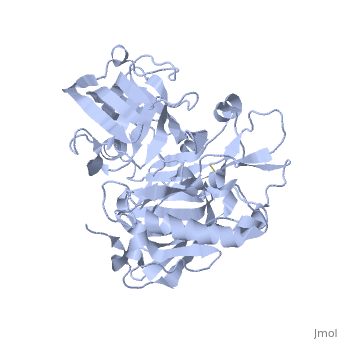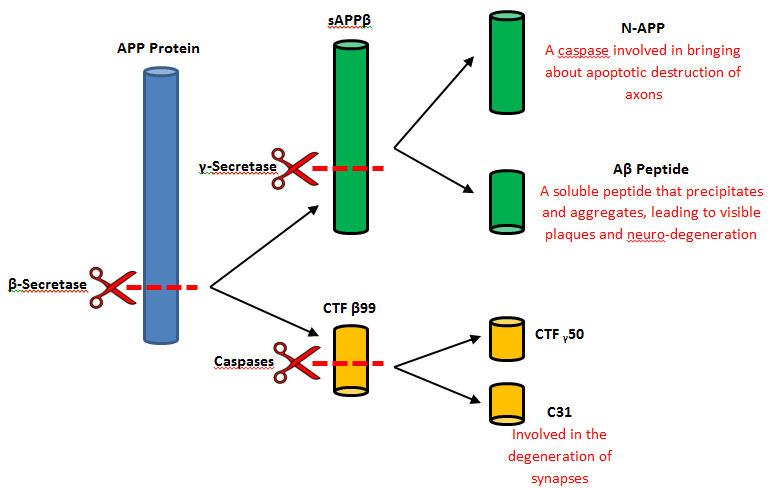Beta Secretase (BACE1) 1SGZ
From Proteopedia
| Line 11: | Line 11: | ||
== Structure == | == Structure == | ||
<StructureSection load='1SGZ' size='340' side='right' caption='Human Beta-secretase (PDB 1SGZ)' scene=''> | <StructureSection load='1SGZ' size='340' side='right' caption='Human Beta-secretase (PDB 1SGZ)' scene=''> | ||
| - | + | BACE1 is a type-1 integral membrane glycoprotein that is affected by the positions on the outer domains of amino acids <ref name="six">Venugopal, C.; Demos, C. M.; Rao, K. S. J.; Pappolla, M. A.; Sambamurti, K. Beta-secretase: Structure, Function, and Evolution. CNS & Neurological Disorders Drug Targets. [Online] 2008. 7(3), 278–294. | |
| - | BACE1 | + | |
http://www.ncbi.nlm.nih.gov/pmc/articles/PMC2921875/ | http://www.ncbi.nlm.nih.gov/pmc/articles/PMC2921875/ | ||
| - | </ref> . | + | </ref> . BACE1 prefers the cleavage of longer substrates over smaller peptide based substrates because of the acidic pH of 4.5. This acidic pH is the result of the cleavage of peptide based substrates. The acidic, polar environment of the enzyme allows a wide variety of substrates to bind to the membrane. Cleavage of soluble substrates is possible in the external environment due to the enzyme’s high Km value which fail to observe in the internal environment <ref name="seven">Shimizu, H.; Tosaki, A.; Kaneko, K.; Hisano, T.; Sakurai, T.; Nukina, N. Crystal Structure of an Active Form of BACE1, an Enzyme Responsible for Amyloid Beta Protein Production. Molecular and Cellular Biology [Online] 2008, 28(11), 3663-671. |
http://mcb.asm.org/content/28/11/3663.full.pdf+html | http://mcb.asm.org/content/28/11/3663.full.pdf+html | ||
| - | </ref>. The two catalytic aspartate residues that reside in the active site of | + | </ref>. The two catalytic aspartate residues that reside in the active site of BACE1 are Asp 32 and Asp 228<ref name="six">Venugopal, C.; Demos, C. M.; Rao, K. S. J.; Pappolla, M. A.; Sambamurti, K. Beta-secretase: Structure, Function, and Evolution. CNS & Neurological Disorders Drug Targets. [Online] 2008. 7(3), 278–294. |
http://www.ncbi.nlm.nih.gov/pmc/articles/PMC2921875/ | http://www.ncbi.nlm.nih.gov/pmc/articles/PMC2921875/ | ||
| - | </ref>. The active site of | + | </ref>. The active site of BACE1 has a flexible, antiparallel-hairpin. This is also known as a flap, which is found in the residues of 67 to 77. These residues control the accessibility of the substrate to the active site. The flap also has to position the substrate in the correct orientation for catalysis. In an open conformation the active site allows the substrate to enter without any difficulty and regulates its activity. In an inactive form the binding affinity to the inhibitor is decreased, which then lowers the substrate binding and enzymatic activity. For the closed conformation the flap with the inhibitor bound is firmly secured in place <ref name="seven">Shimizu, H.; Tosaki, A.; Kaneko, K.; Hisano, T.; Sakurai, T.; Nukina, N. Crystal Structure of an Active Form of BACE1, an Enzyme Responsible for Amyloid Beta Protein Production. Molecular and Cellular Biology [Online] 2008, 28(11), 3663-671. |
http://mcb.asm.org/content/28/11/3663.full.pdf+html | http://mcb.asm.org/content/28/11/3663.full.pdf+html | ||
</ref>. | </ref>. | ||
| - | The S3 pocket is adjacent to the Thr 232 and the amino acids from the 10s loop, which contains Glycine and Glutamine. The Glycine located in the 10s loop | + | Another notable structure found in beta-secretase is the S3 pocket. The S3 pocket is adjacent to the Thr 232 and the amino acids from the 10s loop, which contains Glycine and Glutamine. The Glycine located in the 10s loop forms a hydrogen bond with the substrate that helps to stabilize the 10s loop. This further balances the interaction of the beta-secretase substrate. In an open conformation of the 10s loop, the substrate and the S3 pocket have a greater affinity to bind with each other. The stabilization of the structure depends on the active site, flap and 10s loop <ref> Kumalo, M.; Soumendranath B.; Soliman, M. E. Investigation of Flap Flexibility of β-secretase Using Molecular Dynamic Simulations. Journal of Biomolecular Structure and Dynamics [Online] , 2015, 1-12. |
http://www.tandfonline.com/doi/full/10.1080/07391102.2015.1064831</ref>. | http://www.tandfonline.com/doi/full/10.1080/07391102.2015.1064831</ref>. | ||
| - | Specifically, | + | Specifically, BACE1 is a transmembrane aspartic protease, which cleaves the amyloid-beta precursor protein and produces the amyloid-beta peptide. Two water molecules are utilized in the process of the aspartic protease. The location of the first water molecule for BACE1 is between the Asp 32 and Asp 228. Once the substrate binds, the two aspartate residues form a hydrogen bond with the water molecule. The water molecule becomes the nucleophile and attacks the carbonyl. The second water molecule forms a hydrogen bond with the Tyr residue that is found in the flap. The behavior of the two water molecules affects the activity of BACE1 <ref name="seven">Shimizu, H.; Tosaki, A.; Kaneko, K.; Hisano, T.; Sakurai, T.; Nukina, N. Crystal Structure of an Active Form of BACE1, an Enzyme Responsible for Amyloid Beta Protein Production. Molecular and Cellular Biology [Online] 2008, 28(11), 3663-671. |
http://mcb.asm.org/content/28/11/3663.full.pdf+html | http://mcb.asm.org/content/28/11/3663.full.pdf+html | ||
</ref>. | </ref>. | ||
| Line 49: | Line 48: | ||
---- | ---- | ||
=== Alzheimer's Disease === | === Alzheimer's Disease === | ||
| - | Alzheimer’s disease | + | Alzheimer’s disease is an unfortunate neurodegenerative disease that degrades the nervous system, specifically the destruction of neurons in the brain. The brain mass of a person with this disease is significantly reduced over time as brain neurons and brain function diminishes over time. The amyloid plaque, a product of APP, is what aggregates in the brain and degrades neuron function in the brain. The loss of neuron function and inability to make synapses in the brain eventually leads to dementia in AD patients which reduces the patient’s memory. The reduction of memory results in brain capacity reduced, impacting the functioning of the patient’s normal daily life routines and eventually results in death. In the later stages of Alzheimer’s disease, when brain capacity and function is very low, typically the patient needs to be cared for because they are not able to live their normal life and care for themselves on a daily basis as a normal person would<ref name="thirteen">Vasser, R. The B-Secretase Enzyme in Alzheimer’s Disease. Journal of Molecular Neurosceince. 2004, 23, 105-113. http://link.springer.com/article/10.1385/JMN:23:1-2:105</ref> . |
| - | + | Alzheimer’s disease occurs because of plaques which are formed from a buildup of amyloid beta. Amyloid beta is a four kilodalton protein made up of about 39-43 amino acids in length, which aggregates in the brain and causes the destruction of the brain <ref name="fourteen>Shoji, M.; Golde, T.; Ghiso, J.; Cheung, T.; Estus, S.; Shaffer, L.; Cai, X.; Mckay, D.; Tintner, R.; Frangione, B.; Et, A. Production Of the Alzheimer Amyloid Beta Protein by Normal Proteolytic Processing. Science. 1992, 258, 126–129. | |
</ref>. Amyloid beta is cleaved from the membrane protein APP done so by two proteases, beta-secretase and gamma-secretase. Amyloid betas are amphiphilic peptides with a hydrophilic (water loving) N-terminal side (residues 1-28) and a hydrophobic (water hating) C-terminal side (residues 29-40). These characteristics of the AB is what affects the toxicity of the peptide aggregates in the brain<ref name="fifteen">AnaSpec. Amyloid Peptides. Peptides, http://www.anaspec.com/products/productcategory.asp?id=1</ref>. | </ref>. Amyloid beta is cleaved from the membrane protein APP done so by two proteases, beta-secretase and gamma-secretase. Amyloid betas are amphiphilic peptides with a hydrophilic (water loving) N-terminal side (residues 1-28) and a hydrophobic (water hating) C-terminal side (residues 29-40). These characteristics of the AB is what affects the toxicity of the peptide aggregates in the brain<ref name="fifteen">AnaSpec. Amyloid Peptides. Peptides, http://www.anaspec.com/products/productcategory.asp?id=1</ref>. | ||
Revision as of 03:58, 13 April 2016
Beta-secretase, also known as BACE or Memapsin 2, is encoded by the gene BACE1. Beta-secretase is a proteolytic, transmembrane enzyme with two active sites on the extracellular region. It is associated with processing amyloid precursor protein (APP), which is an integral membrane protein.[1] A malfunction in the processing of APP results in the formation of the peptide amyloid beta. Amyloid-beta is a neurotoxic peptide segment that aggregates into plaques. These plaques are the primary component of plaques found in individuals with Alzheimers Disease. [2] Other biological associations of this enzyme include modulating myelination in the central and peripheral nervous systems.[3]
Enzyme Class
Beta-secretase is an enzyme that is classified as a class 3 enzyme, which are hydrolases [4]. The enzyme acts on breaking peptide bonds and therefore is also considered a peptidase and belongs to the subclass of aspartic acid endopeptidases.[5]
Structure
| |||||||||||
References
- ↑ Ghosh, A.; Kumaragurubaran, N.; Hong, L.; Koelsh, G.; Tang, J. Memapsin 2 (Beta-Secretase) Inhibitors: Drug Development. CAR Current Alzheimer Research. [Online] 2008, 5, 121–131. http://jamesmadisonva.library.ingentaconnect.com/content/ben/car/2008/00000005/00000002/art00004
- ↑ 2.0 2.1 2.2 John, V.; Beck, J. P.; Bienkowski, M. J.; Sinha, S.; Heinrikson, R. L. Human β-Secretase (BACE) And BACE Inhibitors. ChemInform. [Online] 2004, 35, 4625-4630. http://pubs.acs.org/doi/pdf/10.1021/jm030247h
- ↑ Hu, X.; Hicks, C. W.; He, W.; Wong, P.; Macklin, W. B.; Trapp, B. D.; Yan, R. Bace1 Modulates Myelination in the Central and Peripheral Nervous System. Nature Neuroscience Nat Neurosci. [Online] 2006, 9, 1520–1525. http://www.nature.com/neuro/journal/v9/n12/abs/nn1797.html
- ↑ Nomenclature Committee of the International Union of Biochemistry and Molecular Biology. The Enzyme List Class 3 — Hydrolases. http://www.enzyme-database.org/downloads/ec3.pdf
- ↑ DBGET Search. KEGG ENZYME: 3.4.23.46. http://www.genome.jp/dbget-bin/www_bget?ec:3.4.23.46
- ↑ 6.0 6.1 6.2 Venugopal, C.; Demos, C. M.; Rao, K. S. J.; Pappolla, M. A.; Sambamurti, K. Beta-secretase: Structure, Function, and Evolution. CNS & Neurological Disorders Drug Targets. [Online] 2008. 7(3), 278–294. http://www.ncbi.nlm.nih.gov/pmc/articles/PMC2921875/
- ↑ 7.0 7.1 7.2 Shimizu, H.; Tosaki, A.; Kaneko, K.; Hisano, T.; Sakurai, T.; Nukina, N. Crystal Structure of an Active Form of BACE1, an Enzyme Responsible for Amyloid Beta Protein Production. Molecular and Cellular Biology [Online] 2008, 28(11), 3663-671. http://mcb.asm.org/content/28/11/3663.full.pdf+html
- ↑ Kumalo, M.; Soumendranath B.; Soliman, M. E. Investigation of Flap Flexibility of β-secretase Using Molecular Dynamic Simulations. Journal of Biomolecular Structure and Dynamics [Online] , 2015, 1-12. http://www.tandfonline.com/doi/full/10.1080/07391102.2015.1064831
- ↑ 9.0 9.1 9.2 Golub, M. (Producer) & Golub, M. (Director). (2015). Youtube. United States: University of Rochester Introductory Biochemistry
- ↑ 10.0 10.1 Manada, N., Tanokashira, D., Hoska, A., Kametani, F., Tamoka, A,. and Araki, W. (2015). Amyloid beta-protein oligomers upregulate the beta-secretase, BACE1, through a post-translational mechanism involving its altered subcellular distribution in neurons. Molecular Brain, Vol. 8, p.1-12. 12p. doi: 10.1186/s13041-015-0163-5
- ↑ Sugana, K., Padlan E., Smith, C., Carlson, W., and Davis, D. (1987). Retrieved April 5, 2016 from

- ↑ JCSciphile, March - Beta-Secretase, 2014, Web, Retrieved April 5, 2016 from http://jcsciphile.com/molecule-of-the-month/march-beta-secretase/
- ↑ Vasser, R. The B-Secretase Enzyme in Alzheimer’s Disease. Journal of Molecular Neurosceince. 2004, 23, 105-113. http://link.springer.com/article/10.1385/JMN:23:1-2:105
- ↑ Shoji, M.; Golde, T.; Ghiso, J.; Cheung, T.; Estus, S.; Shaffer, L.; Cai, X.; Mckay, D.; Tintner, R.; Frangione, B.; Et, A. Production Of the Alzheimer Amyloid Beta Protein by Normal Proteolytic Processing. Science. 1992, 258, 126–129.
- ↑ AnaSpec. Amyloid Peptides. Peptides, http://www.anaspec.com/products/productcategory.asp?id=1
- ↑ Thompson, L.; Bronson, J.; Zusi, C.; Progress in the discovery of BACE Inhibitors. Current Pharmaceutical design. 2005, 11, 3383-3404
- ↑ 17.0 17.1 Ghosh, A. K.; Brindisi, M.; Tang, J. Developing β-Secretase Inhibitors for Treatment of Alzheimer’s Disease. Journal of Neurochemistry. [Online] 2011, 120, 71–83.http://onlinelibrary.wiley.com/doi/10.1111/j.1471-4159.2011.07476.x/full



